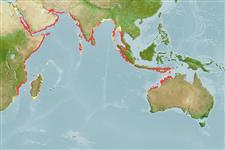Actinopterygii (ray-finned fishes) >
Perciformes (Perch-likes) >
Pinguipedidae (Sandperches)
Etymology: Parapercis: Greek, para = the side of + Greek, perke = perch (Ref. 45335).
Environment / Climate / Range
Ecology
Marine; reef-associated; depth range 8 - 25 m (Ref. 90102). Tropical, preferred ?
Western Indian Ocean.
Size / Weight / Age
Maturity: Lm ? range ? - ? cm
Max length : 20.0 cm TL male/unsexed; (Ref. 11441)
Dorsal
spines
(total): 5;
Dorsal
soft rays
(total): 21;
Anal
spines: 1;
Anal
soft rays: 17;
Vertebrae: 30. This species is distinguished by the following characters: body color in life light brown dorsally, center of scales whitish, 6 irregular, semicircular brown blotches along back that link narrowly to large dark brown spots on about lower 2/3 of body, with the spots vertically elongate anteriorly, horizontally elongate and darker posteriorly; head orangish brown with small dark brown spots dorsally on snout and nape, 7 narrow bluish white bars (3 on opercle and preopercle, 4 radiating from ventral and anterior part of eye); dorsal and anal fins are translucent whitish, the spinous dorsal with a large black basal spot mainly between the 3rd and 5th spines; rows or round orange spots on soft dorsal fin; small irregular white spots on anal fin; dark brown about lower third of caudal fin with small whitish spots along rays, the rest of the fin light grey with small white and orange spots along rays; D V,21, all rays branched; A I,17 all rays branched; pectoral rays 16-17, branched except uppermost; 57-58 lateral line scales; gill rakers 4-6 + 8-10; lower jaw projecting, 3 pairs of canine teeth anteriorly in jaws; palatine teeth absent; vomerine teeth in a chevron-shaped patch of 3-4 rows; greatest body depth 5.05-6 in SL; head length (HL) 3.5-3.9 in SL; orbit diameter 3.6-4.4 in HL; preopercle's posterior margin with widely spaced, small, blunt serrae; opercle scales ctenoid, cheek scales weakly ctenoid dorsally, becoming cycloid, progressively smaller, nonimbricate ventrally; fourth dorsal spine is the longest, 3.1-3.8 in HL; caudal fin emarginate on dorsal half, often with protruding upper lobe, becoming rounded on ventral half; pectoral fins 5.1-5.4 in SL; pelvic fins just reaching anus (Ref. 79876).
Coastal species found in shallow estuaries and protected coastal bays to depths of about 25 m (Ref. 48636). Inhabit sand bottoms solitarily (Ref. 90102). Minimum depth reported from Ref. 48636.
Life cycle and mating behavior
Maturity | Reproduction | Spawning | Eggs | Fecundity | Larvae
Randall, J.E., 2008. Six new sandperches of the genus Parapercis from the Western Pacific, with description of a neotype for P. maculata (bloch and Schneider). The Raffles Bull. Zool. 19:159-178. (Ref. 79876)
IUCN Red List Status (Ref. 115185)
CITES (Ref. 94142)
Not Evaluated
Threat to humans
Harmless
Human uses
More information
Common namesSynonymsMetabolismPredatorsEcotoxicologyReproductionMaturitySpawningFecundityEggsEgg development
ReferencesAquacultureAquaculture profileStrainsGeneticsAllele frequenciesHeritabilityDiseasesProcessingMass conversion
Tools
Special reports
Download XML
Internet sources
